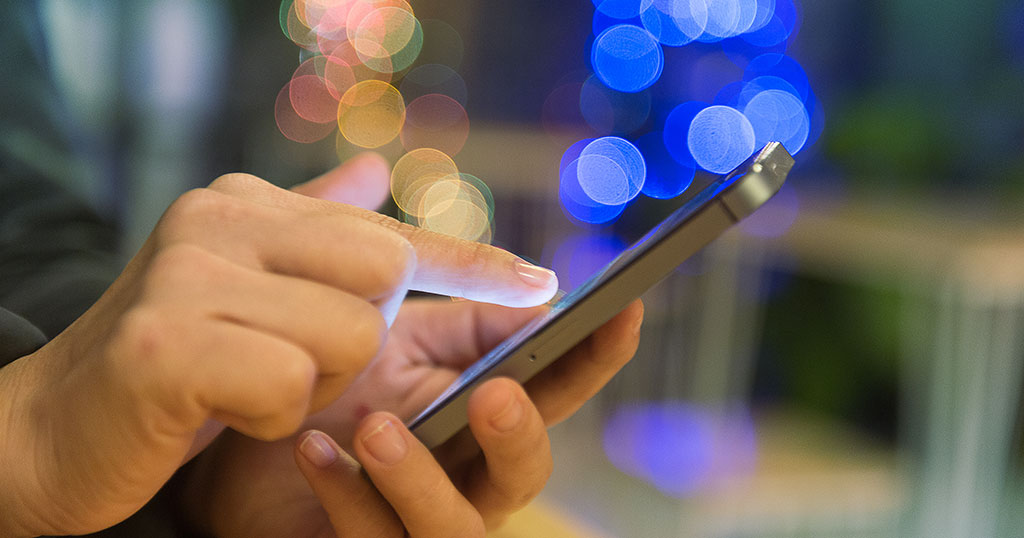
Blue light has a dark side
This week’s blog on Blue light has a dark side has been contributed by Dr Osama Giledi, Consultant Ophthalmologist, Specialist in Cataract, Cornea and Refractive Vision Correction Surgery
What is blue light? The effect blue light has on your sleep and your health
Visible light is a lot more complicated than people may think.
Phones, tablets, televisions, electronic devices, LED lighting, streetlights, and even energy efficient light bulbs in your home; almost everything we interact with during the day emits blue light – including the sun shining above us.
We’re exposed to a broad spectrum of different kinds of visible (and sometimes invisible) light that can have a range of effects on your health. From retinal damage to a potential loss of vision, blue light is a risk to our health and should be considered.
Blue light is the portion of the visible light spectrum with the shortest wavelengths and highest energy ranging from 380 to 500nm. The sky looks blue because of blue light wavelengths from the sun.
The sun’s blue light regulates our body’s natural wakefulness and sleep cycle, called the circadian rhythm. Blue light affects melatonin production, the hormone that controls the circadian rhythm.
When the sun comes up in the morning, melatonin production comes to a natural halt and when it sets production starts back up again, telling the body to prepare for sleep and restoration, so we can refuel for the day ahead.
When we look at our electronic devices late at night, our melatonin production is reduced as a result. This is because blue light signal your pineal gland to stop producing melatonin. To your brain, blue light registers similarly to natural daylight, “tricking” your body to become more awake and alert which may cause sleepless nights and daytime fatigue.
Our circadian rhythms are naturally designed to synchronize with the rising and setting of the sun meaning that when the sun is out, our mind and bodies are alert and awake.
But circadian rhythm controls more than your sleep. This body rhythm regulates dozens of bodily functions like hormones, cellular health, blood sugar levels and metabolism and possibly even more functions we aren’t aware of yet.
Melatonin suppression has been linked with sleep disorders, increased diabetes, obesity, heart disease and even some forms of cancer.
When we aren’t in tune with our biological clock, our system begins to wear down, leaving us vulnerable to disease.
As technology improves, the amount of digital consumption through personal devices increases. The ease at which users are able to watch a movie on their phone or tablet, holding the screens in such close proximity to their eyes could mean potential long term damage to their eyes.
The eye is not very good at blocking blue light, especially in children. With age our lenses absorb some of the blue light and reduce the amount of blue light that reaches the retina.
Some blue light exposure can also be good for your health. Studies have shown that blue light exposure can boost your bodies alertness, help memory and even lift your mood. Light therapy has even been used to help with the treatment of depression.
Blue light can also contribute to digital eye strain, because short-wavelength, high energy blue light scatters more easily than other visible light, which means it isn’t as focused.
When you look at your television or laptop screen, your eyes are looking at unfocused visual “noise”.
These unfocused wavelengths are stressful on the eyes because they must constantly focus and re-focus on these flickering waves in our visual field. This creates glare or fuzziness in your vision, which is a common cause of headaches, fatigue, and eyestrain.
How can we combat the negative effects of prolonged exposure to screens?
Blue light blocking glasses and lenses have been developed to combat the effects of prolonged exposure to blue light. However, studies have shown that these lenses may increase contrast significantly. For a more comfortable experience when looking at a digital device for extended periods of time, yellow tinted lenses can be used to reduce strain on your eyes.
Researchers suggest that prolonged exposure to blue light could cause progressive destruction of retinal cells in the eyes therefore contributing to age-related macular degeneration, which is one of the leading causes of blindness.
Alternatively, nearly all visible blue light reaches the retina through the cornea and lens. For people who have cataracts and are about to have surgery, you can have an intraocular lens (IOL) surgically implanted with in-built blue light protection.
What about prolonged phone use?
If you are using your phone a lot, a convenient way to reduce your blue light exposure is to use a blue light filter. The blue light filter function is featured in some devices’ display settings and available to download from the relevant app stores. This filter limits the amount of blue light reaching your eyes without affecting the quality of the resolution and display. These are available for most modern digital devices including smartphones, tablets and computers and help to reduce the amount of blue light produced reaching your eyes.
Even better, stop using digital devices for a while before going to sleep.
Look for bulbs with opaque coatings to reduce bright light emissions. Or better yet, find a dimmable or colour-changing bulb that allows for softer light in the evening.
You can also use a dimmer on your tech screens. The mobile operating system activates blue light filtering at night. (Images: Apple Inc.)
Also, you can use some applications such as fl.ux for computers and laptops to reduce the light emitted from your devices and adjust it for the time of the day.
Computer users and those who work night shift can protect themselves by wearing blue light blocking glasses.
A Harvard study found evidence that blue-light blocking goggles are effective against the melatonin suppression response of blue light. Night shift workers are especially encouraged to invest in blue-light blocking goggles
https://www.health.harvard.edu/staying-healthy/blue-light-has-a-dark-side

